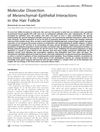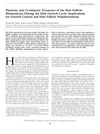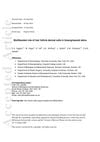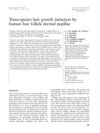TLDR HEY2+ cells help regenerate skin during wound healing.
This study investigates the role of HEY2+ cells in dermal regeneration and wound healing. Using genetic lineage tracing in mice, researchers found that HEY2 is predominantly expressed in dermal papilla (DP) during the telogen phase and that HEY2+ cells contribute to the regeneration of dermal cells during wound healing. The study utilized Hey2-CreERT2 knockin mice and Rosa26-ZsGreen reporter mice to trace the fate of HEY2+ cells. Results showed that a significant number of dermal fibroblasts in regenerated skin were ZsGreen+ lineage cells, indicating that Hey2+ DP cells, dermal sheath cells, and dermal fibroblasts possess stemness and participate in dermal regeneration. Additionally, HEY2+ cells exhibited higher expression levels of growth factors like VEGF, FGF7, and HGF, which are known to promote wound healing. The study suggests that DP cells may migrate between the DP and dermal sheath during the hair growth cycle, contributing to dermal regeneration. Further research is needed to determine the applicability of these findings to humans.
173 citations
,
August 2015 in “Developmental cell” The study identified unique genes in hair follicle cells and their environment, suggesting these genes help organize cells for hair growth.
 417 citations
,
September 2005 in “PLoS biology”
417 citations
,
September 2005 in “PLoS biology” Understanding gene expression in hair follicles can reveal insights into hair growth and disorders.
 54 citations
,
June 2003 in “The journal of investigative dermatology. Symposium proceedings/The Journal of investigative dermatology symposium proceedings”
54 citations
,
June 2003 in “The journal of investigative dermatology. Symposium proceedings/The Journal of investigative dermatology symposium proceedings” Disruptions in hair follicle fibroblast dynamics can cause hair growth problems.
 January 2022 in “Journal of St. Marianna University”
January 2022 in “Journal of St. Marianna University” Substances from human hair cells can affect hair loss-related genes, potentially leading to new treatments for baldness.
 33 citations
,
September 2016 in “British journal of dermatology/British journal of dermatology, Supplement”
33 citations
,
September 2016 in “British journal of dermatology/British journal of dermatology, Supplement” Human hair follicle dermal cells can effectively replace other cells in engineered skin.
 15 citations
,
April 2014 in “Experimental Dermatology”
15 citations
,
April 2014 in “Experimental Dermatology” Scientists developed a system to study human hair growth using skin cells, which could help understand hair development and improve skin substitutes for medical use.
 321 citations
,
December 2009 in “Journal of Dermatological Science”
321 citations
,
December 2009 in “Journal of Dermatological Science” Dermal cells are key in controlling hair growth and could potentially be used in hair loss treatments, but more research is needed to improve hair regeneration methods.
January 2003 in “Chinese Journal of Reparative and Reconstructive Surgery” Dermal papilla cells can help form hair follicles and produce hair.
 66 citations
,
August 2001 in “Experimental Dermatology”
66 citations
,
August 2001 in “Experimental Dermatology” Human hair follicle cells can grow hair when put into mouse skin if they stay in contact with mouse cells.
 57 citations
,
November 1998 in “Wound Repair and Regeneration”
57 citations
,
November 1998 in “Wound Repair and Regeneration” Hair papilla cells can create and regenerate hair bulbs under the right conditions.







